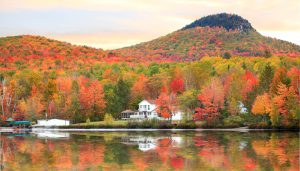The six states in the northeastern corner of the United States collectively known as New England sometimes experience dry and hot spells that set the forests ablaze with the rich colors of autumn. These prolonged periods of warmer temperatures are known as Indian Summers. The forests of New England are second or third generation forests, but they are holding up well. The terrain is less suitable for agriculture due to the mostly shallow and rocky soils. The White Mountains National Forest in New Hampshire, with an area of over 3,000 square kilometers in size or just over 750,000 acres, contains both coniferous forests were hemlock and Eastern white pine are the dominant species, and deciduous forests with maple, beech and birch species. Sugar maple, Red maple and Silver maple straddle these two forest types. We encountered similar forest types in Group 12. The leaf of the Sugar maple, by the way, is the emblem of Canada, a tree species that generously supplies the maple syrup that Americans love to pour on their breakfast pancakes. Yellow birch and Sugar birch share characteristics that set them apart from other birch species like the Paper birch which looks more familiar to a European. Both maple and birch provide good wood for the furniture industry, the latter used intensively in plywood production.


